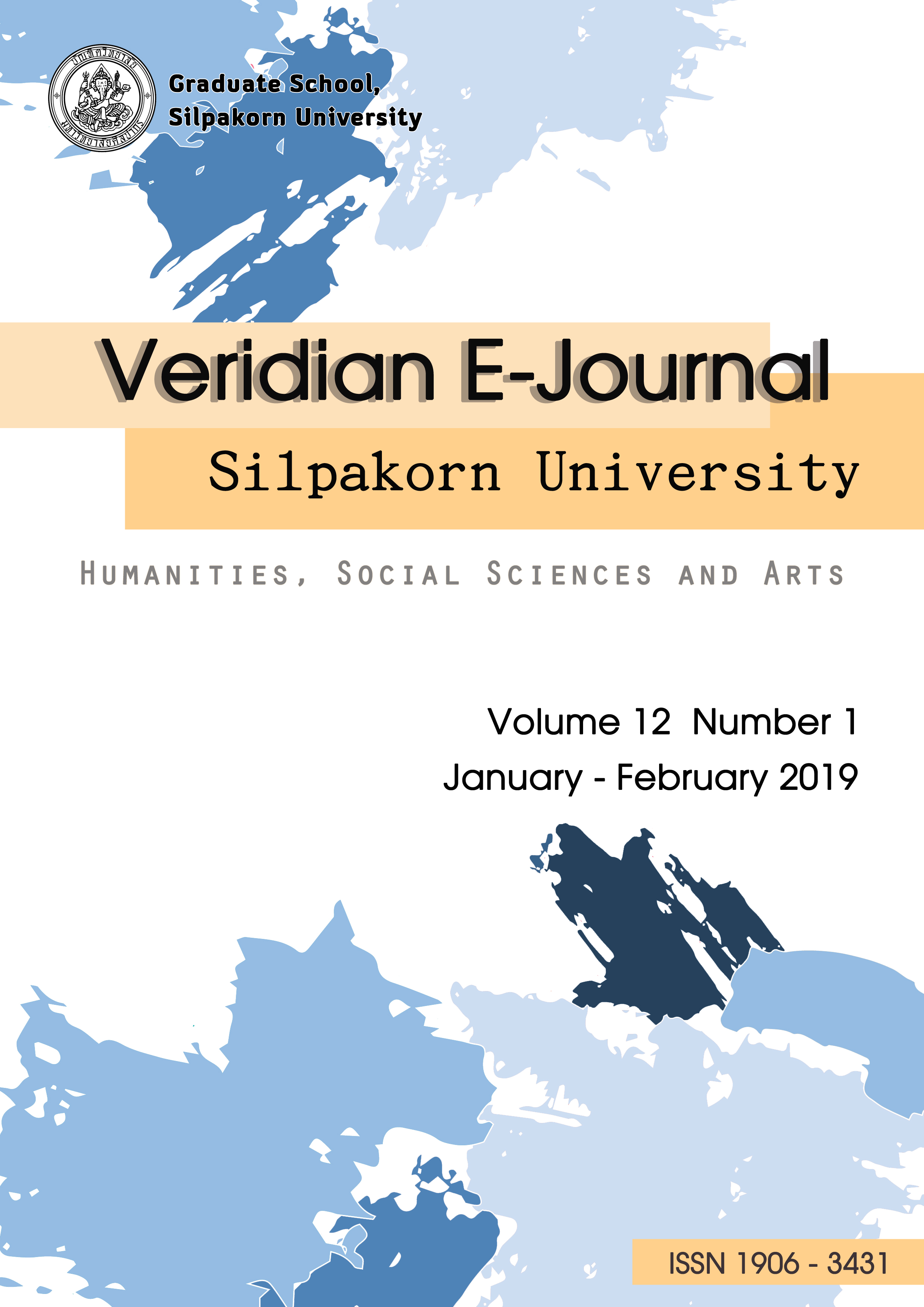กลยุทธ์และเครือข่ายการสื่อสารโครงการธนาคารปูม้า ศูนย์ศึกษาการพัฒนา อ่าวคุ้งกระเบน อันเนื่องมาจากพระราชดำริ (Strategic and Communications Network for Blue Swimming Crab Sustainability Project in Kung Krabaen Bay Royal Development Study Center.)
Main Article Content
Abstract
งานวิจัยนี้มีวัตถุประสงค์เพื่อศึกษากลยุทธ์การสื่อสารและลักษณะเครือข่ายการสื่อสาร รูปแบบความ ร่วมมือของเครือข่ายโครงการธนาคารปูม้า ศูนย์ศึกษาการพัฒนาอ่าวคุ้งกระเบนฯ เป็นการวิจัยเชิงคุณภาพ เก็บรวบรวมข้อมูลด้วยการวิจัยจากเอกสาร การลงพื้นที่ การสังเกตการณ์แบบมีส่วนร่วม การสัมภาษณ์เชิงลึกและ การสนทนากลุ่มจากผู้ให้ข้อมูลสำคัญ ผลการศึกษาพบว่า กลยุทธ์การสื่อสารของเครือข่ายประกอบด้วย 2 กลยุทธ์ กลยุทธ์เกี่ยวกับผู้ส่งสารมีแนวทางการสื่อสารที่ใช้การสร้างความน่าเชื่อถือ ความไว้วางใจ ความตั้งใจจริง และการปรับสารให้เข้ากับผู้รับสาร กลยุทธ์ด้านสารได้มีแนวทางในการนำเสนอสารในเรื่องการเพิ่มความอุดมสมบูรณ์ของปูม้าภายในอ่าวคุ้งกระเบนที่ชี้ให้เห็นถึงการเกิดประโยชน์ร่วมกันต่อการประกอบชีพประมง กลยุทธ์การใช้สื่อ พบว่า เครือข่ายไม่มีงบประมาณในการผลิตสื่อเฉพาะกิจ ใช้สื่อบุคคล โซเชียลมีเดีย วิทยุสื่อสาร ลงพื้นที่ สื่อกิจกรรมและสื่อมวลชนต่างๆ ลักษณะเครือข่ายการสื่อสารเป็นลักษณะการทำงานที่มีรูปแบบความร่วมมือเป็นหุ้นส่วนความสำเร็จสามารถตรวจสอบได้ เครือข่ายจะมีศูนย์ศึกษาการพัฒนาอ่างคุ้งกระเบนฯทำหน้าที่เป็นศูนย์กลาง (central) และมีองค์ความรู้ระบบธนาคารปูม้าเป็นสะพาน (bridges) ที่เชื่อมโยงระหว่างกลุ่ม(cluster) เครือข่ายสมาชิกด้วยกันหรือลูกข่าย (peripherals) รูปแบบความร่วมมือของเครือข่ายประกอบด้วย การเป็นเวทีกลางประสานความร่วมมือ แลกเปลี่ยนองค์ความรู้ ข้อมูลวิชาการ ทรัพยากร ตลอดจนการสร้างกระแสผลักดันประเด็นใหม่ๆและเผยแพร่ถ่ายทอดความรู้ประชาสัมพันธ์โครงการ
This study aims to study communication strategies and communication network characteristics. Cooperation model of Blue Swimming Crab Sustainability Project in Kung Krabaen Bay Royal Development Study Center. The research found that Network communication strategy consists of two main strategies: proactive strategy and reciprocal strategy. The messenger strategy have a communication approach that builds trust, trust, willingness. And adapt the substance to the recipient. The strategy for substance delivery has been the introduction of the substance, emphasizing the increase in abundance of Blue Swimming Crab within Kung Krabaen Bay. And to point out the long-term mutual benefits. The benefits of fishing are based on motivating techniques to change attitudes and behaviors. The media strategy found that the network had no budget for producing specialized media, most of it was personal media, used for discussion, radio talk, media monitoring, space activities, coordination platform for related issues. And new media and mass media. The characteristics of the communication network is a collaborative nature, the partnership can be successfully verified. The network will have a center for Kung Krabaen Bay Royal Development Study Center, which serves as a central hub and a cognitive banking system. The blue swimming crabs are bridges that link between the cluster, member network, or the client. The information flow control is based on mutual benefits. The composition of the network consists of four groups of people. The direction of communication is the direction of communication in a horizontal communication in two-way communication, the direction of information flow in the network. Appears in 3 categories from 5 categories. The cooperation model of the network consists of a central platform for cooperation. Knowledge Exchange Information on resources, as well as the creation of new issues and dissemination of knowledge and public relations.
Article Details
References
ภาษาไทย
เกรียงศักดิ์ เจริญวงศักดิ์. (2543). การจัดการเครือข่าย:กลยุทธ์สำคัญสู่ความสำเร็จของการปฎิรูป
การศึกษา. กรุงเทพฯ: ซัคเซส มีเดีย.
กาญจนา แก้วเทพ. (2548). ก้าวต่อไปของการสื่อสารเพื่อการพัฒนาชุมชน. สำนักงานกองทุนสนับสนุนการวิจัย(สกว.). กรุงเทพมหานคร : ห้างหุ้นส่วนจำกัด ซีโน ดีไซน์.
ณัฏฐ์สุดา วิจิตรจามรี. (2558). การสื่อสารในองค์กร.สำนักพิมพ์เกษตรศาสตร์. ศูนย์หนังสือมหาวิทยาลัยเกษตรศาสตร์.
ภารดี พึ่งสำราญ. (2557). กระบวนการสื่อสารปรัชญาเศรษฐกิจพอเพียงในการแพร่กระจายนวัตกรรมภูมิปัญญาท้องถิ่น กรณีศึกษาศูนย์ศึกษาการพัฒนาอ่าวคุ้งกระเบน อันเนื่องมาจากพระราชดำริ.
สุรพงษ์ โสธนะเสถียร์. (2559). ทฤษฎีการสื่อสาร. กรุงเทพ. โรงพิมพ์ระเบียงทอง.
ปาริชาติ วลัยสเถียร. (2543). กระบวนการและเทคนิคการทำงานของนักพัฒนา. กรุงเทพฯ:
สำนักงานกองทุนสนับสนุนการวิจัย.
ยุบล เบ็ญจรงค์กิจ (2554). การวางแผนและการประเมินผลการสื่อสารเชิงกลยุทธ์. โครงการตำรา.
คณะนิเทศศาสตร์. จุฬาลงกรณ์มหาวิทยาลัย.
อุธร ฤทธิลึก. (2556). การจัดการทรัพยากรประมง. กรุงเทพ. โอเดียนสโตร์.
อรวรรณ ปิลันธน์โอวาท. (2554). การสื่อสารเพื่อโน้มน้าวใจ. กรุงเทพฯ : โรงพิมพ์จุฬาลงกรณ์มหาวิทยาลัย.
ภาษาต่างประเทศ
Taylor J.W. (1990). Developing Winning Strategic Plans. Maywood, NJ.: Alexander Hamilton Institute lnc.
Smith, R.D. (2009). Strategic Planning for Public Relations. Mahwah, New Jersey : Lawrence Erlbaum Associates.
FAO. Rome Declaration on World Food Security and World Food Summit Plan of Action. World Food Summit, 1996. https://www.fao.org/wfs.
